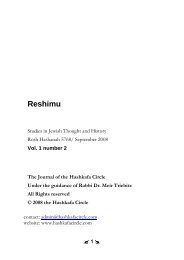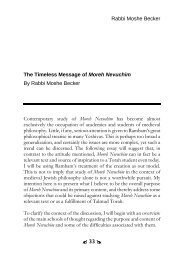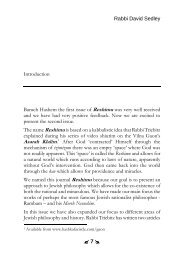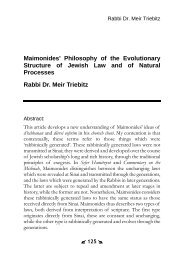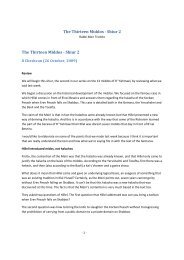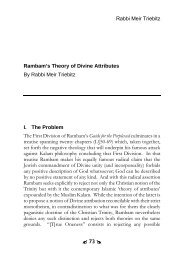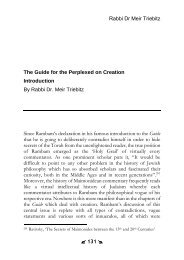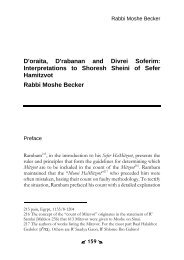Reshimu_3_journal_no.. - Hashkafa Circle
Reshimu_3_journal_no.. - Hashkafa Circle
Reshimu_3_journal_no.. - Hashkafa Circle
You also want an ePaper? Increase the reach of your titles
YUMPU automatically turns print PDFs into web optimized ePapers that Google loves.
Rabbi Meir Triebitz<br />
commentaries with important consequences for understanding their<br />
views on the redaction of the Talmud. Tosafot (ibid 9b) reject Rav<br />
Acha’s position and concludes that the Halacha is in accordance with<br />
the a<strong>no</strong>nymous section. They justify their ruling on historical<br />
grounds. The a<strong>no</strong>nymous section represents the position of Rav<br />
Ashi, who came later than Rav Acha, and there is a principle that the<br />
Halacha follows the later opinion. This is in accordance with their<br />
position in Chullin 2b cited above that the a<strong>no</strong>nymous give-and-take<br />
of the Talmud is from Rav Ashi. And also because he is the<br />
a<strong>no</strong>nymous voice of the Gemara. Thus the Halacha must be like Rav<br />
Ashi for two reasons:<br />
1. Rav Ashi lived later than Rav Acha ben Yaakov, and<br />
2. He was the final redactor of the Gemara<br />
Rav Ashi’s opinion, both with respect to the reading of the Mishna<br />
and the consequential ruling, must be given greatest legal weight. 3<br />
In contrast to Tosafot, the Rif arrives at the opposite halachic<br />
conclusion. He writes that the phrase “close to the time of Mincha”<br />
in the Mishna is “concluded” by the Gemara (a reference to Rav<br />
Acha bar Yaakov) to mean “close to the time of Mincha Gedolah”. The<br />
Rif then goes on to explain the prohibition in accordance with the<br />
position of Rav Acha bar Yaakov.<br />
There are two ways of understanding the Rif’s halachic position.<br />
Either:<br />
1. The a<strong>no</strong>nymous section is <strong>no</strong>t from Rav Ashi or anyone of his<br />
generation (i.e. in direct contradiction to the opinion of Tosafot), but<br />
rather represents a conclusion reached during or before the time of<br />
3 It is interesting to <strong>no</strong>te that the Tosafot is <strong>no</strong>t at all concerned with the fact that<br />
Rav Acha bar Yaakov is seemingly responding to a position arrived at historically<br />
after his lifetime. This would appear to be in accordance with the position of the<br />
Rashbam quoted above in Ketubot 2b and Zevachim 102b, objected to by Rabbeinu<br />
Tarn.<br />
51



